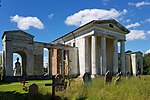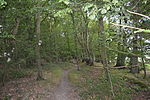Old St Lawrence Church, Ayot St Lawrence
Buildings and structures in Ayot St LawrenceChurch ruins in EnglandChurchyards in EnglandCommonwealth War Graves Commission cemeteries in EnglandGrade II* listed churches in Hertfordshire ... and 1 more
Ruins in Hertfordshire

Old St Lawrence Church is a ruined building in Ayot St Lawrence, Hertfordshire, England. It is protected as a Grade II* listed building, and dates back to the 12th century.The building was partially demolished in 1775 by Sir Lionel Lyde, 1st Baronet, who had acquired a country home, Ayot House, close by. It was replaced as the village's parish church by new St Lawrence Church, a neoclassical structure which Lyde had built on a site slightly further from his house. The last baptism to take place at Old St Lawrence Church was on the 21st February 1773 for Susan George. New St Lawrence Church was consecrated in 1779.
Excerpt from the Wikipedia article Old St Lawrence Church, Ayot St Lawrence (License: CC BY-SA 3.0, Authors, Images).Old St Lawrence Church, Ayot St Lawrence
Hill Farm Lane, Welwyn Hatfield Ayot St Lawrence
Geographical coordinates (GPS) Address Nearby Places Show on map
Geographical coordinates (GPS)
| Latitude | Longitude |
|---|---|
| N 51.837738 ° | E -0.267306 ° |
Address
Old Church (remains of)
Hill Farm Lane
AL6 9BU Welwyn Hatfield, Ayot St Lawrence
England, United Kingdom
Open on Google Maps








